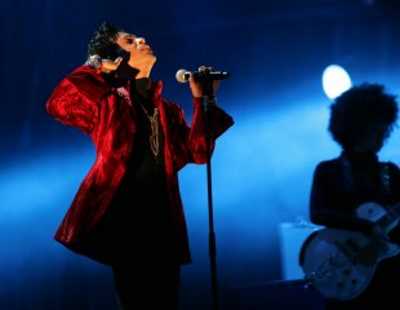| |
Taken from Alternet (May 04, 2018)
Bringing Back the Funk in the Heart of Trump Country
One nation, under funk.
by Valerie Vande Panne, Independent Media Institute

BUDAPEST, HUNGARY - AUG 9: The rock/ pop/ funk musician Prince in concert at the annual Sziget Festival in Budapest, Hungary, on Tuesday, August 9, 2011.
Photo Credit: Northfoto/Shutterstock |
Funk is one of those quintessentially American genres of music that has been exported the world over. George Clinton, Parliament, the Ohio Players, Bootsy Collins, Zapp, Lakeside, Platypus, Brides of Funkenstein, Klymaxx, Slave… the list goes on. If you don’t know these artists, you have heard them. They’ve been sampled by everyone from N.W.A. to Justin Bieber; Notorious B.I.G. to Bruno Mars. James Brown is the genre’s father. Prince is perhaps its most celebrated '80s son.
And like all great American music, funk has its soul rooted firmly in a uniquely American heart: the Miami Valley of Ohio, sandwiched between the Mason Dixon line and Motown.
And it’s here, in Dayton—a place that voted definitively for Trump in 2016—where the Funk Music Hall of Fame and Exhibition Center—or just, “The Funk Center”—opened their doors this spring.
David Webb, the Funk Center’s founder and executive director, likes to muse that “Dayton is the funkiest place on Earth.”
It’s said that God planted his foot here, and sweat into the soil. The aquifer beneath sucked up God’s sweat, and when the people drank it, funk was born. There’s something, the locals will tell you, in the water.
Whether that’s true or not—and who can say for certain it isn’t?—what is true is that some of the funkiest musicians called Dayton home, from the Ohio Players to Lakeside to Slave.
These musicians, and so many more in the genre, played and performed with different funk groups on albums and in live concerts as the groove moved them, switching bands faster than athletes are traded between teams. The result is you can hear Ohio musicians at various times with Slave, P-Funk, Parliament, etc. From this Midwestern town, that funky style forever changed music history and race relations in the United States.
“Back then [in the 1960s], black people could only shop in one side of the city,” says Webb, of the early days of funk in Dayton. “Dayton was a segregated city. Funk played a big role in bringing people together. Black, white, everybody came together. Everybody enjoyed the music. It broke those racial barriers. It opened up other avenues. We gelled together. When they [blacks and whites] started listening to funk music, it opened doors. It was beautiful.”
The fledgling museum is a testament to that racial harmony, of One Nation Under a Groove, and all things treasured in funk. Walking in, visitors are greeted by “Mount Funkmore”—a giant mural, painted by Delora Buchanan, a Dayton local who also happened to design some of those outlandish costumes funk stars wore on stage.
The Funk Center displays a selection of those fabulous clothes: sequined man-rompers, fur-trimmed capes, clear plastic suits, Christmas-light strung jackets, and feathered fedoras. It’s all here: the glam, the battery-powered clothing, the silver short pants. It’s an exhibition that could be at the Costume Institute of the Metropolitan Museum of Art, but instead, it’s here, in Dayton, and is just a small part of the reason to make the pilgrimage.
Also on display is everything from keyboards and guitars to sexy and explicit album covers, and rare show posters to the “money suitcase”—that treasure chest bands carried that pre-dated ATMs and easy credit.
Also memorialized at the Funk Center is Roger Troutman’s efforts to provide low-interest loans for working-class people across the Dayton area to be able to purchase their own homes at a time when redlining might have otherwise prevented it.
The Funk Center has such an incredible and growing collection because local family and friends kept everything from gold records to original, duct-taped-together drum kits, in basements and attics across Ohio, and they’ve generously donated them to the Funk Center.
These various components embody the spirit of the genre and are captured at the Funk Center, with a raw sense of camaraderie.
That funk legacy, says Webb, must be preserved, and is “important to our children. Our kids need to understand that.”
The meaningful expression, as played by the trained musicians of the genre, is the most important part of funk, says Larry Lang, the Funk Center’s Chief Funk Ambassador. “You can do whatever you want and be ridiculous, and it doesn’t mean anything,” he says.
In funk, that expression, Lang adds, is “the manifestation of experience.” It’s a unity that grows through and from the genre.
Here at the Funk Center, it’s easy to forget politics and venture into an analogue space, where the United States is, indeed, united. In funk.
|
|